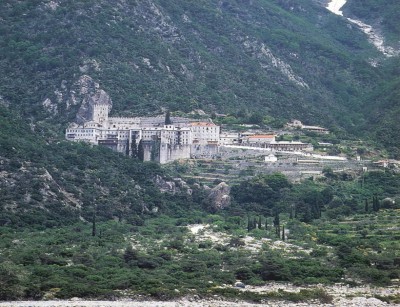The Touristic Info Halkidiki informs: Mount Athos - Monasteries and skites
Moni Agiou Pavlou
Greek-orthodox holiday: February 2
The Monastery is located south of the West Coast.
The exact period of its founding is uncertain, but it is in the 10th Century. There is a connection with a monk named Paulos, but we don’t know who he was exactly. Originally it was probably one of the Skits of the monastery Xiropotamou.
Around the year 1360AD there could be two Serbian monks from the monastery Xiropotamou the ones who purchased the Skit. And was already in 1394AD counted on the then existing 25 big monasteries. Various documents by Byzantine emperors and the Serbian Prince confirmed the importance of the monastery for the 14th Century.
The Slavic influence remained for some centuries. This is because the abbots of the monastery, both in the 15th as well as in the 16th Century, used Slavic drafts in their writings. Even for the period around 1700AD, there is evidence that the monastery was the house of Slavic and Greek monks.
Prosperity came to the monastery from the year 1500AD, with the help of a Romanian prince. During the Greek War (1821AD-1830AD), however, the monks left their monastery.
In 1840AD Greek monks started from the ruins and built the new monastery.
In 1902AD the newly built monastery was destroyed by a devastating fire. Again, they set to work and built anew. Because of this relatively young building history of the monastery it is now considered a modern but mighty fortress monastery.
It has got nearly 500 valuable writings and more than 12,000 ancient books and also by far the most valuable treasure of all the monasteries in Athos, the grains of myrrh that the Three Kings gave as a present to the infant Jesus. Also interesting are the frescoes dating back to 1423AD, with which the chapel of Agios Georgios is decorated.

Your rental car in Halkidiki
From the airport Thessaloniki, Hotel, Apartment and Studio in whole Chalkidiki. No credit card needed. Fast, easy and safe. For 3 days only from 63.- € !

















